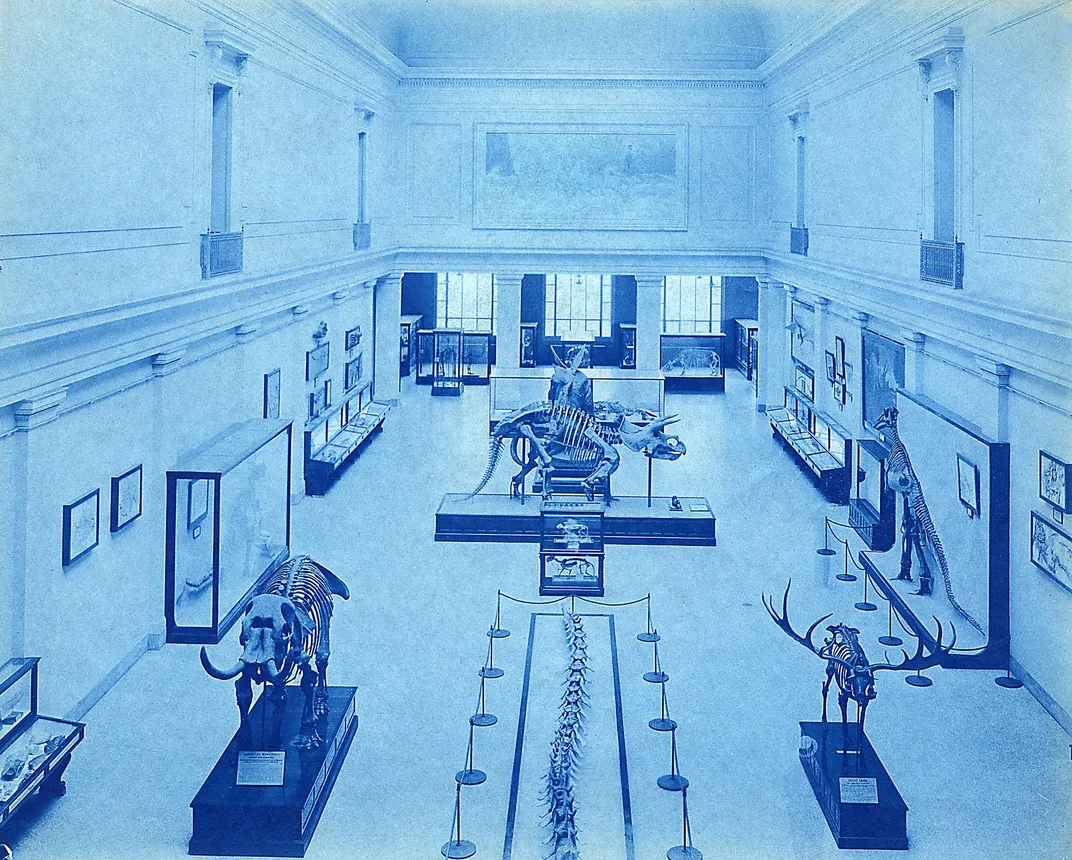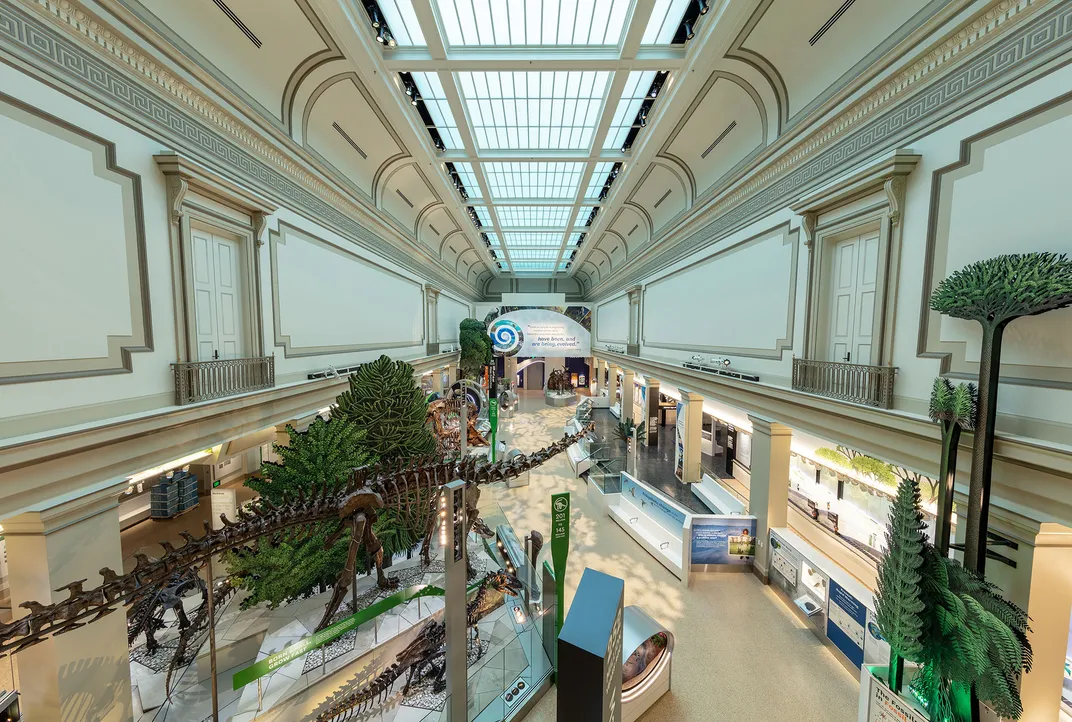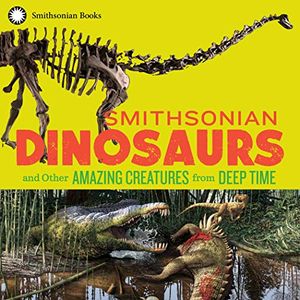Amid All the Fossils, Smithsonian’s New Dinosaur Exhibition Tells the Complex Story of Life
The much-anticipated exhibition is packed full of Mesozoic dinosaur drama, new science, hands-on discoveries and state-of-the-art museum artistry
:focal(1000x667:1001x668)/https://tf-cmsv2-smithsonianmag-media.s3.amazonaws.com/filer/19/51/19516385-2aae-4f05-9ee0-6fa5c4682ebb/nmnh-2019-00508.jpg)
Time runs through everything. It is not simply a matter of setting an alarm to wake up for work, agreeing on when to meet a friend, or how many years we’ve spent on the planet. Time is what connects our present moment to every other that has come before, allowing us to delve into the past to assemble some understanding of how our current moment came to be—and what might yet happen.
Paleontology, the study of ancient life, is one of the intellectual time machines that humanity uses to investigate and understand nature’s big picture. The National Museum of Natural History has embraced the science since the museum's inception, from the days when “Hatcher” the Triceratops graced the museum’s early “Hall of Extinct Monsters” until the beginning of the 21st century, when the museum decided to close its much-loved dinosaur hall for a lengthy renovation and refresh of the science.
Towering dinosaurs, early amphibians, ancient elephants, and more all gave testament to the strange times and places they once inhabited in Earth history. But now, after years being reconsidered and reshuffled, those familiar prehistoric fossils come back to us to tell a different story. They’ve come to tell us of our connection to “Deep Time.”
Fossils are often treated as tattered remnants of lost worlds, of times vastly different from our own inhabited by bizarre beings with little connection to our modern Earth. But in planning and designing what the new Smithsonian exhibition “Hall of Fossils—Deep Time” should look like, the museum’s paleontologists and exhibit specialists had something different in mind. Each fossil represents a story that joins a grander narrative of life's epic history—from the rise of the first organisms through the parade of majestic prehistoric creatures and beyond, to the future.
“The question we asked ourselves when we started this, is ‘What things about paleontology are different now than the last time the hall was renovated?’” says Smithsonian paleobotanist Scott Wing. The science had undergone an incredible growth spurt over the past several decades, moving far beyond the stereotype of simply collecting and cataloging old bones to a field that considers Earth systems, ecology, and the connections between life of different ages. “It’s not only changed how we study things,” Wing says, “but why we study them.”
Any fossil—no matter how mundane or spectacular—is part of multiple stories of life’s evolution and how organisms responded to their constantly-changing environments. “We now study the fossil record because it helps us understand the processes by which the Earth and life changed through time,” Wing says, “and being geologic-scale changers of the environment ourselves, we need to know how those things work and how we’re changing them now.”
The question was how to tell that story while working in the existing exhibition space. “The biggest challenge is how do you tell 3.7 billion years of life’s story in one space—but also make it meaningful and relevant to a visitor in 2019?” says museum exhibits specialist Siobhan Starrs.
The first step was starting with the flow of the tale. The traditional story of life on Earth often starts with the beginning, around 3.7 billion years ago, from there winding up through time to show the evolutionary connections and transformations that altered the shape of nature. “Deep Time” deconstructs that narrative, starting with the present and moving backward, following connections from our own time deeper and deeper into the past.
/https://tf-cmsv2-smithsonianmag-media.s3.amazonaws.com/filer/c0/80/c0804626-6f39-425a-b0d5-fa7f54eaf2de/nmnh-2018-01015.jpg)
Smithsonian Dinosaurs and Other Amazing Creatures from Deep Time
Smithsonian Dinosaurs and Other Amazing Creatures from Deep Time presents some of Earth's strangest and most unusual creatures from as early as 3.8 billion years ago. Beginning with the first evidence of life, it moves through periods of biodiversity and mass extinction and into a look at the first dinosaurs, mammals, pterosaurs, and other fauna and flora from the Archean to the Quarternary eras.
The journey starts even before visitors set foot into the new hall. Henry, the museum’s storied bull elephant in the rotunda, is an iconic, imperiled species in our own time. But as soon as visitors step into the new hall, they’re welcomed by a trumpeting American mastodon—a connection to the Ice Age world of not so very long ago, which began a paltry 2.6 million to 11,700 years ago. Picking up the timeline from there, the exhibition journeys back through the 40 million-year-old hothouse world of the Eocene, the heyday of giant Jurassic dinosaurs 150 million years ago, and the catastrophe at the end of the Permian, 252 million years ago, that wiped out about 75 percent of life on Earth—and beyond.
Naturally, some of the museum’s huge, charismatic megafauna determined the flow of the story. Tyrannosaurus, Camarasaurus, Diplodocus and many more dinosaurian friends all still inhabit the hall, but their sheer size (Diplodocus measures 90-feet long) required a great deal of space, especially because the museum decided to mount them dramatically, in ways that have never been done before.
Meet the Dinos of Deep Time
As intricate and structurally beautiful as most museum dinosaur mounts might be, many are typically staged in relatively static poses or in displays that reinforce the old stereotype that dinosaurs were snarling monsters of distant epochs. In the Smithsonian's new hall, while there is certainly Mesozoic drama—like T. rex readying to tear the head off Triceratops—a little time spent among the titans in their new displays will reveal other facets of their day-to-day lives that help place them in the broader context of life’s ever-changing story.
/https://tf-cmsv2-smithsonianmag-media.s3.amazonaws.com/filer/0a/7d/0a7d93c5-1b37-4590-9128-c349e367a582/nhb2017-00040.jpg)
“Life is messy,” Starrs says, and the exhibit designers thought hard about how dinosaurs left a footprint on their environments—both literally and figuratively. A Torosaurus, similar to Triceratops, wanders through a Cretaceous forest in a new mural, breaking twigs as it goes. A dome-headed dinosaur called Stegoceras scratches its nose. A brooding Allosaurus curls its tail around its nest. A hungry Camarasaurus rears up to munch on Jurassic branches. “On a personal level, this was closest to my heart,” says Smithsonian dinosaur curator Matthew Carrano, “trying to make these animals seem like they were once real animals and doing something real animals do.”
An intense amount of work was required to come up with these new displays, and the behind-the-scenes efforts have already started to fuel new scientific research. Some of the dinosaurs from the old fossil hall were still partly encased in the rock from their original excavation in the late 1800s. The old exhibits not only had to be dismantled, but some of the dinosaurs had to be prepared anew, revealing information that was previously hidden. The museum’s extraordinary skeleton of the Jurassic meat-eating dinosaur Ceratosaurus, for example, included hand bones that had never been fully described before and were recently studied by Carrano.
/https://tf-cmsv2-smithsonianmag-media.s3.amazonaws.com/filer/79/ce/79ce17a1-87d6-4b81-9a69-075b3639fd10/nhb2017-00061.jpg)
Starrs notes that research into how visitors interact with exhibits and social science was part of the planning as well, in an effort to make the exhibits as interesting and accessible to as many people as possible.
And, following the powerful thread of climate change through time, Wing notes that a specialized conference was carried out over the course of several days to come up with the clearest look at climate shifts through time. The meeting is leading to new approaches in tracking how our world has changed.
“Deep Time” is the culmination of hundreds of years of work by innumerable scientists and community members, from the Smithsonian’s own experts and curators to the 19th-century fossil hunters who dug some of these specimens out of the ground. And what comes together is an integrated view of life where distinct stories become bundled together into the flow of time’s grand narrative. “Visitors will pick up on the fact that things are changing through time, ecosystems are changing as well as animals, and it’s an interconnected system from the beginning of life to the future,” says Smithsonian vertebrate paleontology curator Anna Kay Behrensmeyer.
/https://tf-cmsv2-smithsonianmag-media.s3.amazonaws.com/filer/47/5e/475ed964-16ee-4e82-94c1-e8248413c8bc/nhb2017-02022stegosaurus.jpg)
But what will that future look like? “Deep Time” doesn’t simply stop with the Ice Age, or consider humans outside of the rest of nature. To the contrary, the exhibition drives home the point that the choices we make—from the broader cultural use of fossil fuels to power our lives to the development or conservation of landscapes—have dramatic and increasingly dire impacts on our world. This is where “Deep Time’s” message truly hits home, because it’s only by looking to the past that we can plan for the future.
About 50 million years ago, for example, the Earth went through a natural temperature spike comparable to what humans are creating today with the use of fossil fuels. The complex story of how animal and plant life responded is a preview of what might transpire if we continue on our present course. The importance of the ecological turning point we now stand at is on full display, not only showing visitors how we’re shaping our legacy but also asking them what is worth protecting and how people just like them are starting to make changes.
“We still have a choice,” Behrensmeyer says. What we do next will leave its mark on the planet just as surely as the life of any dinosaurs. Everyone receives a legacy from previous generations and gives one to the next. “What’s your legacy going to be?” Wing asks.
Connection runs through “Deep Time.” There are the connections between prehistoric organisms—whether it’s photosynthesizing bacteria, part of a prehistoric reef, a dinosaur, an ancient mammal or a tree that made up part of an Eocene forest—but there is also our own connection to the past. Everything on display in the exhibition, every fossil, has some relevance to the world we live in today. “I’m hoping visitors walk in expecting a dinosaur hall and they walk away with something much bigger than that,” Starrs says, with the concept that “this story has meaning and relevance to me—to all of us—right now.”
Humans are not the endpoint or goal of this story. Life will go on with or without us, Behrensmeyer notes. But we are not isolated from the evolutionary and environmental phenomena that have so dramatically shaped all these forms of life over millions and millions of years. What’s unprecedented is that our species can make choices about what’s to come.
“We should try to keep ecosystems as strong as possible so that we can find a future that has a lot of elements that we like about the present,” Behrensmeyer says. There’s something wondrous about that. Not only are we uncovering these stories in paleontology’s vibrant Renaissance era, but we are inextricably intertwined with the past lives we wish to understand.
Or, as Carrano succinctly puts it, “We’re part of this story just like everything else.”
Listen to the premiere episode of season 4 of Sidedoor, a podcast from the Smithsonian, which details how scientists O.C. Marsh and Edward Cope went from good friends who named species after each other to the bitterest of enemies who eventually ruined each other's lives and careers.
A Note to our Readers
Smithsonian magazine participates in affiliate link advertising programs. If you purchase an item through these links, we receive a commission.
/https://tf-cmsv2-smithsonianmag-media.s3.amazonaws.com/accounts/headshot/RileyBlack.png)



/https://tf-cmsv2-smithsonianmag-media.s3.amazonaws.com/filer/71/32/7132de46-6c9a-4cfb-b720-9199f7517931/nmnh-2019-00484_2.jpg)
/https://tf-cmsv2-smithsonianmag-media.s3.amazonaws.com/filer/cb/97/cb978e23-4edc-4cd6-8b40-962c4894dcb2/nmnh-2019-00507.jpg)
/https://tf-cmsv2-smithsonianmag-media.s3.amazonaws.com/filer/be/6a/be6a44ae-8e34-430b-9bba-5e344b089662/nmnh-2019-00501.jpg)
/https://tf-cmsv2-smithsonianmag-media.s3.amazonaws.com/filer/a2/fe/a2fedad6-64ec-46b6-88d7-5b903141b5ea/nmnh-2019-00504.jpg)
/https://tf-cmsv2-smithsonianmag-media.s3.amazonaws.com/filer/56/54/5654090a-9869-4e7c-a57c-b0d4d6b4bfff/nmnh-2019-00510.jpg)
/https://tf-cmsv2-smithsonianmag-media.s3.amazonaws.com/filer/ef/bc/efbc63d9-5af6-4456-9171-0c9cf9e166c8/nmnh-2019-00512.jpg)
/https://tf-cmsv2-smithsonianmag-media.s3.amazonaws.com/filer/4b/72/4b7262f1-24d4-4b10-a7d6-ef4a9d1b2e0e/nmnh-2019-00513.jpg)
/https://tf-cmsv2-smithsonianmag-media.s3.amazonaws.com/filer/64/52/64529192-b370-426b-b6c2-af4138ba55e3/nmnh-2019-00514.jpg)
/https://tf-cmsv2-smithsonianmag-media.s3.amazonaws.com/accounts/headshot/RileyBlack.png)